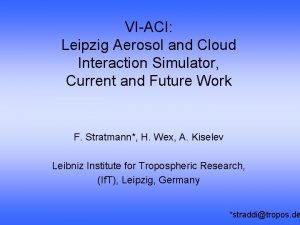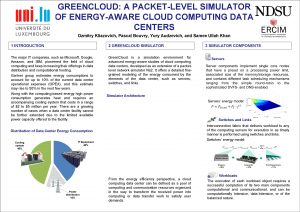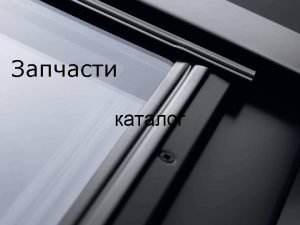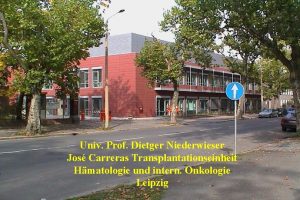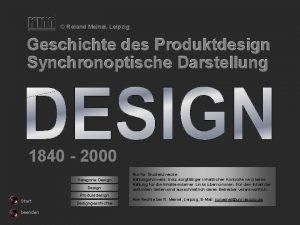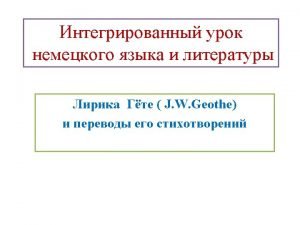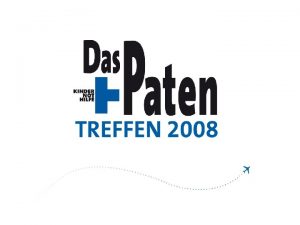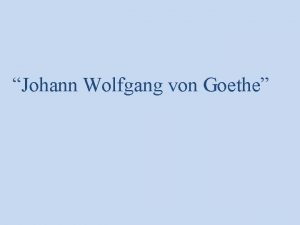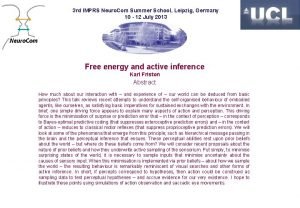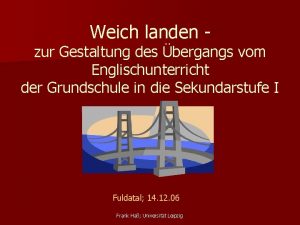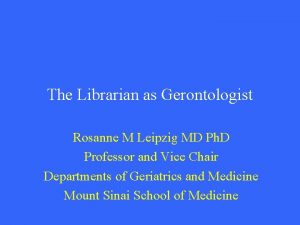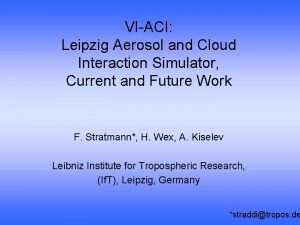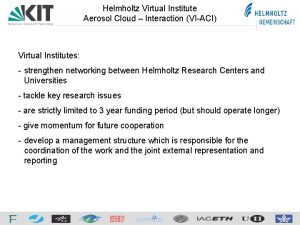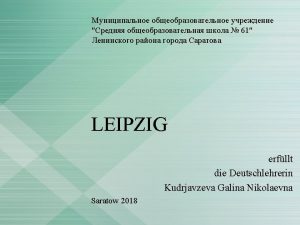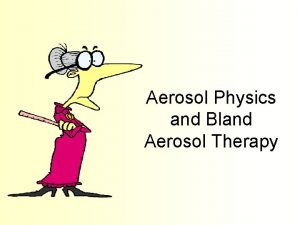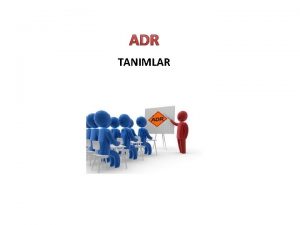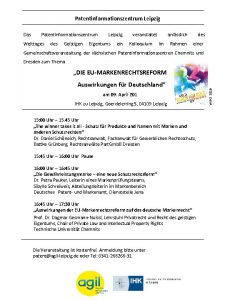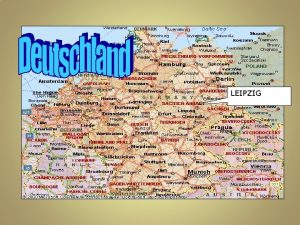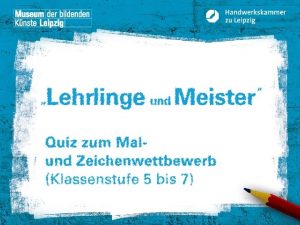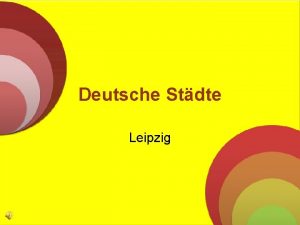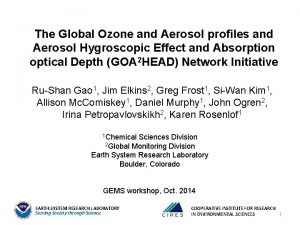VIACI Leipzig Aerosol and Cloud Interaction Simulator Current
















- Slides: 16

VI-ACI: Leipzig Aerosol and Cloud Interaction Simulator, Current and Future Work F. Stratmann*, H. Wex, A. Kiselev Leibniz Institute for Tropospheric Research, (If. T), Leipzig, Germany *straddi@tropos. de

Leipzig Aerosol Cloud Interaction Simulator (LACIS) laminar flow diffusion cloud chamber • maximum length 10 m ● maximum residence time 60 sec ● temperature regime Tlab to -50°C ●

Laminar Flow Diffusion Chamber (LFDC)

sub-saturation: Tdew point < TLACIS wall almost 0 up to 99. 5% super-saturation: Tdew point > TLACIS wall down to two- to threetenth of a percent

LACIS: Current Version length 1 m ● residence time 1. 5 sec ● temperature regime Tlab to 2°C ● optical sizer at tube outlet ●

LACIS: Features LACIS can be used to investigate • particle hygroscopic growth at relative humidities up to 99. 5 % (and higher) • particle/droplet activation and dynamic growth at supersaturations down to 0. 1 % • homogeneous and heterogeneous droplet freezing down to temperatures of -50 °C • uptake of soluble gases and their influence on hygroscopic growth and activation A numerical model describing the coupled fluid and particle dynamical processes inside LACIS is available for experiment layout and data interpretation (possible contribution to WP M 1)

LACIS has been used to study 1. Particle hygroscopic growth under subsaturated conditions 2. Activation of lab-generated aerosol particles 3. CCN closure for HULIS particles 4. Hygroscopic growth and activation of laboratory -generated aerosol particles imitating combustion aerosols (LEx. No)

Deliquescence of 90% succinic acid, 10% ammonium sulfate particles, DRHtheory = 98. 7%

LACIS has been used to study 1. Particle hygroscopic growth under subsaturated conditions 2. Activation of lab-generated aerosol particles 3. CCN closure for HULIS particles 4. Hygroscopic growth and activation of laboratory -generated aerosol particles imitating combustion aerosols (LEx. No)

Critical super-saturations in dependence on the mass of levoglucosan per particle

Critical super-saturations in dependence on the mass of levoglucosan per particle

LACIS: Status • Hygroscopic growth and activation measurements with LACIS-short are running on a routine basis. • A model to describe the hygroscopic growth, activation and dynamic growth of mixed particles (e. g. , ammonium sulfate + succinic acid) is available. Other substances are possible if thermodynamic data is available. • A field version of LACIS will be available in fall this year and we are planning to send it to AIDA and PSI in September. • Particle generators for both pure soot and minerals are available (Palas, RSG mini. CAST, TSI fluidized bed generator). Further testing is needed. • Coater for organic substances is available, ammonium sulfate coater is being rebuilt.

LACIS: Status (continued) • Beam stability in LACIS-long has been successfully tested. • Experiments regarding possible duration times of freezing experiments are on their way. Currently, duration times of 6 to 8 hours seem to be possible. • However, modifications to the setup will be necessary. Time frame for completion is late fall this year. • Optical particle counter with backscattering linear depolarization channel for discrimination of nonspherical particles is being tested. Integration of SID 2 H for evaluation of ice crystal shapes is planned.

WP L 2: Current and Future Research Measurements of CCN properties • CCN-closure studies, i. e. , the determination of CCN properties from measurements of hygroscopic growth properties, will be continued. • Special focus will be given to the derivation of critical supersaturations needed for droplet activation based on water activities and surface tensions derived from hygroscopic growth measurements at high relative humidities (r. h. > 95%). • Effects of organic substances (mainly as coatings) on hygroscopic particle growth, activation and droplet dynamic growth will be studied. As insoluble cores both soot and different minerals will be investigated.

WP L 2: Current and Future Research Measurements of ice nucleation • Ice nucleation experiments will focus on immersion freezing processes. • Special focus will be given to the determination of freezing temperatures as function of size, composition and shape of the seed particles on which the freezing droplets are formed. LACIS-Field (possible contribution to WP L 1, L 3, L 4) • A mobile version of LACIS will be available this fall for use at aerosol/cloud chambers (AIDA, SAPHIR, PSI, …) outside If. T and in field measurements.

WP L 2: To be discussed • What particles substances should be investigated (soot and minerals coated with ammonium sulfate and dicarboxylic acids, …) ? • When shall we perform the combined CCN and freezing measurement campaign at LACIS (spring 2008) ? • What additional instruments do we want/need regarding: – particle generation (FZK, ETH, …) – chemical analysis (AMSs Mainz & ICG-II, …) – IN and CCN efficiencies (ETH, ICG-II, …) – particle physical characterization (HTDMA, …) • …
 Viaci
Viaci Green cloud simulator
Green cloud simulator Ggl leipzig
Ggl leipzig Dietger niederwieser
Dietger niederwieser Our teacher will go to leipzig tomorrow
Our teacher will go to leipzig tomorrow Produktdesign leipzig
Produktdesign leipzig Was studierte goethe in leipzig
Was studierte goethe in leipzig Sixtinische madonna goldener schnitt
Sixtinische madonna goldener schnitt Colin schindler leipzig
Colin schindler leipzig Friederike brion model
Friederike brion model Imprs leipzig
Imprs leipzig Hwk leipzig
Hwk leipzig Sprechfreude leipzig
Sprechfreude leipzig Rosanne leipzig
Rosanne leipzig Sba leipzig
Sba leipzig Line current and phase current
Line current and phase current Line current and phase current
Line current and phase current
